“We’ve learned through decades of artificial lighting studies that red and orange light are the most efficient colors to drive photosynthesis in most plant species. We also know that providing red and orange light alone is not the proper spectrum to give plants. With red light alone, you then tend to get tall, but weak and lanky plants. So it’s important to retain some blue light and to modify the balance of red and blue in your spectrum,” explains Damon Hebert, Director of Agriculture Research at UbiQD, Inc., makers of UbiGro. UbiGro Inner is a luminescent retrofit greenhouse film that converts UV and blue light into orange and red light, using the Nobel Prize-winning technology of quantum dots. At MJBizCon, the company launched its new UbiGro Cover: a polyethylene cover that is made to be on the exterior of the greenhouse. “Both products offer a way to tailor your spectrum without the use of artificial lighting.”
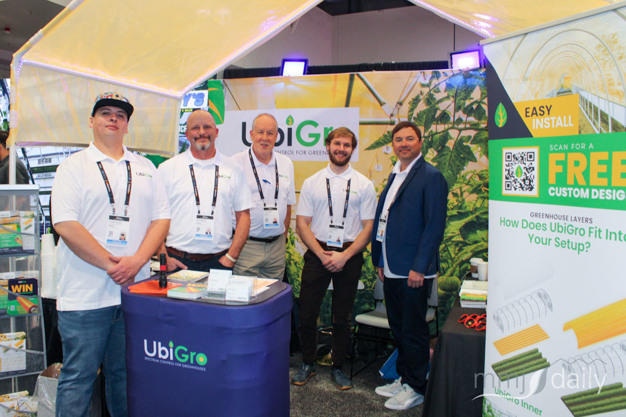 The UbiGro team at this year's MJBizCon: Tyler Veyna, Eric Moody, Jim Gideon, Alex Duero and Hunter McDaniel
The UbiGro team at this year's MJBizCon: Tyler Veyna, Eric Moody, Jim Gideon, Alex Duero and Hunter McDaniel
 Damon Hebert
Quantum dots
Damon Hebert
Quantum dots
How does the technology work? The films have nanoparticles called quantum dots embedded in them, Damon explains. “Quantum dots are very good at converting one color to another with almost perfect efficiency. You might think of it like a filter, but a filter blocks some colors and lets other colors through, meaning that you lose light intensity. With a luminescent material instead, we’re using this color conversion property of quantum dots to maintain the highest possible PAR light transmission through the films, while tailoring the color spectrum of sunlight to improve crop growth,” Damon explains. The film converts some of the UV and blue light that is contained in excess in sunlight, taking some of that out in favor of red and orange. “It’s a modification of the sun’s spectrum. As a result, we typically see yield improvements of anywhere between 5-25%, depending on the crop, climate and location.”
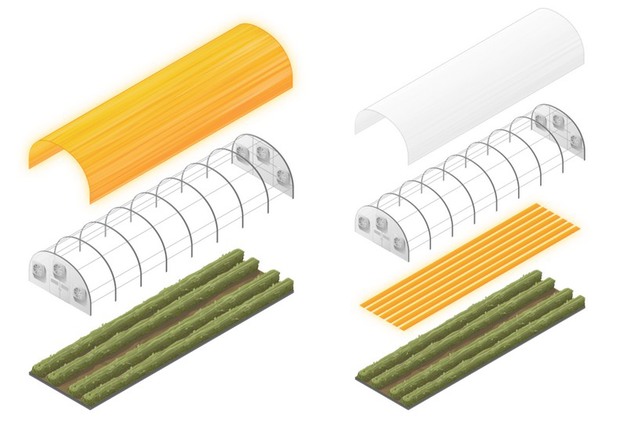 The UbiGro Cover and UbiGro Inner
The UbiGro Cover and UbiGro Inner
Damon explains that the UbiGro Inner and Cover offer a way to tailor your spectrum without the use of artificial lighting. “Of course, you can put LED or HPS lights in the greenhouse and tailor the spectrum. Yet lighting is expensive, both upfront and concerning the operational expenditure over time. On top of that, if you can use a non-electrical solution, you’re reducing your carbon footprint,” Damon says. That being said, many of UbiGro’s customers use artificial lighting as well as the film. “It’s not one or the other, it can be used in tandem. Yet for growers who don’t have access to electricity or who can’t make the investment to add lighting in their greenhouse, it’s a great way to improve the natural sunlight they use.”
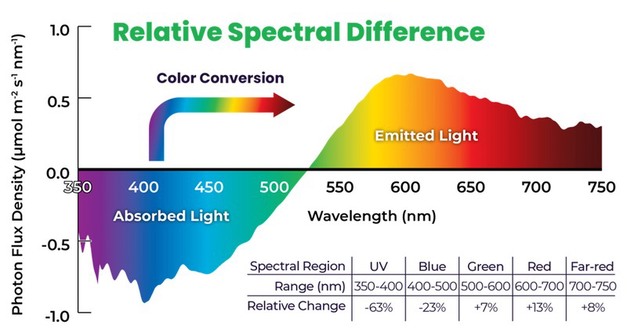 Cover launch
Cover launch
Ever since UbiGro started with their Inner film, growers have asked them to put the quantum dots in the cover itself. “That way, the cover can simply be replaced. The Inner, on the other hand, is a new layer within the greenhouse, which growers aren’t always used to. So the ability to change out the cover is a major advantage,” Damon says. Yet that was quite a difficult engineering challenge to solve. “It’s on the exterior of the greenhouse. So we needed to put a nanoparticle like quantum dots into a polyethylene product that can withstand the weather and UV, for example. We’re excited to have achieved it and be able to launch it now. We already have two installations done so far,” Damon says.
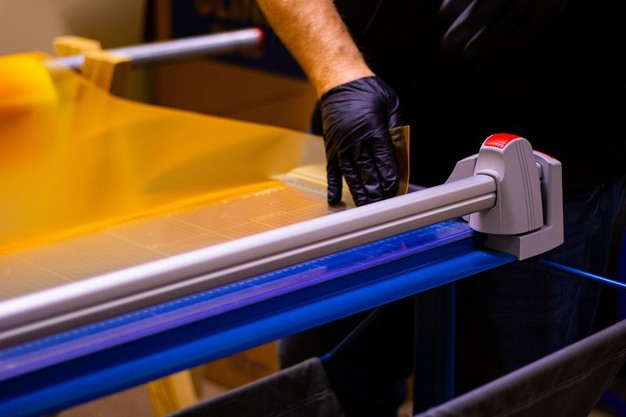 Mature markets
Mature markets
Damon says that they’ve seen a lot of demand in the mature cannabis markets. “When new states open up, there tends to be excitement and more investment. Yet most new states start indoors and gradually move to larger facilities that have lower costs. Cost is not yet as important in a new market, because the prices and margins are high. When the market starts to mature, people are trying to produce high-quality cannabis at the lowest possible cost. We’ve seen that high-quality greenhouses are a popular solution in mature markets. Most of our cannabis installations have been in California, Oregon and Colorado, so far,” Damon says.
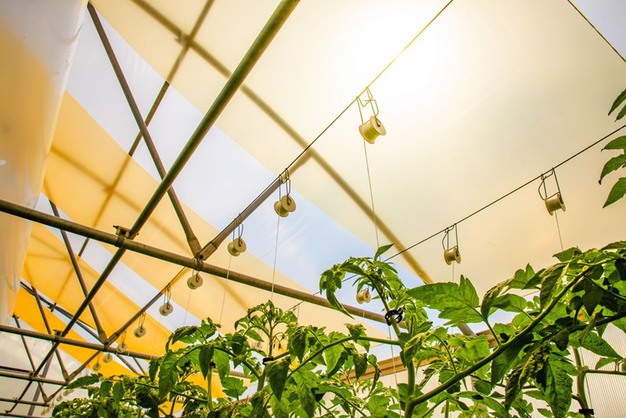
In those mature markets, the UbiGro products have provided a great solution for cannabis growers. “They want to set themselves apart from their competitors, too. So, if they can improve their sustainability without using more electricity, that’s a great way to differentiate themselves, while also improving their bottom line,” Damon says. “For cannabis, the ROI is very fast: usually in just one or two harvests for something that lasts 4 years.”
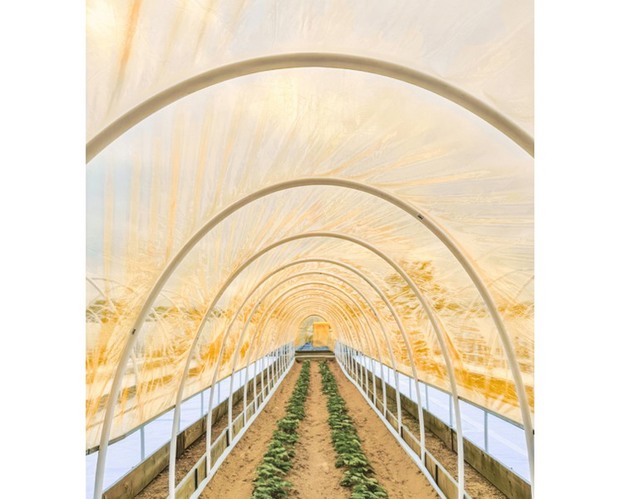 Pilot program
Pilot program
Damon also manages UbiGro’s pilot program. “We work with growers to collect data. We’ve done over 55 pilots worldwide on all sorts of crops, and the program continues to grow. We often offer discounts for growers who are interested in starting a pilot with us. So, it’s a great opportunity to start using the product more affordably, while gathering data and seeing the difference it makes.” Feel free to contact Damon for more information.
For more information:
UbiGro
[email protected]
https://ubigro.com/
Read the original article
here.
 The UbiGro team at this year's MJBizCon: Tyler Veyna, Eric Moody, Jim Gideon, Alex Duero and Hunter McDaniel
The UbiGro team at this year's MJBizCon: Tyler Veyna, Eric Moody, Jim Gideon, Alex Duero and Hunter McDaniel
 Damon Hebert
Quantum dots
How does the technology work? The films have nanoparticles called quantum dots embedded in them, Damon explains. “Quantum dots are very good at converting one color to another with almost perfect efficiency. You might think of it like a filter, but a filter blocks some colors and lets other colors through, meaning that you lose light intensity. With a luminescent material instead, we’re using this color conversion property of quantum dots to maintain the highest possible PAR light transmission through the films, while tailoring the color spectrum of sunlight to improve crop growth,” Damon explains. The film converts some of the UV and blue light that is contained in excess in sunlight, taking some of that out in favor of red and orange. “It’s a modification of the sun’s spectrum. As a result, we typically see yield improvements of anywhere between 5-25%, depending on the crop, climate and location.”
Damon Hebert
Quantum dots
How does the technology work? The films have nanoparticles called quantum dots embedded in them, Damon explains. “Quantum dots are very good at converting one color to another with almost perfect efficiency. You might think of it like a filter, but a filter blocks some colors and lets other colors through, meaning that you lose light intensity. With a luminescent material instead, we’re using this color conversion property of quantum dots to maintain the highest possible PAR light transmission through the films, while tailoring the color spectrum of sunlight to improve crop growth,” Damon explains. The film converts some of the UV and blue light that is contained in excess in sunlight, taking some of that out in favor of red and orange. “It’s a modification of the sun’s spectrum. As a result, we typically see yield improvements of anywhere between 5-25%, depending on the crop, climate and location.”
 The UbiGro Cover and UbiGro Inner
Damon explains that the UbiGro Inner and Cover offer a way to tailor your spectrum without the use of artificial lighting. “Of course, you can put LED or HPS lights in the greenhouse and tailor the spectrum. Yet lighting is expensive, both upfront and concerning the operational expenditure over time. On top of that, if you can use a non-electrical solution, you’re reducing your carbon footprint,” Damon says. That being said, many of UbiGro’s customers use artificial lighting as well as the film. “It’s not one or the other, it can be used in tandem. Yet for growers who don’t have access to electricity or who can’t make the investment to add lighting in their greenhouse, it’s a great way to improve the natural sunlight they use.”
The UbiGro Cover and UbiGro Inner
Damon explains that the UbiGro Inner and Cover offer a way to tailor your spectrum without the use of artificial lighting. “Of course, you can put LED or HPS lights in the greenhouse and tailor the spectrum. Yet lighting is expensive, both upfront and concerning the operational expenditure over time. On top of that, if you can use a non-electrical solution, you’re reducing your carbon footprint,” Damon says. That being said, many of UbiGro’s customers use artificial lighting as well as the film. “It’s not one or the other, it can be used in tandem. Yet for growers who don’t have access to electricity or who can’t make the investment to add lighting in their greenhouse, it’s a great way to improve the natural sunlight they use.”
 Cover launch
Ever since UbiGro started with their Inner film, growers have asked them to put the quantum dots in the cover itself. “That way, the cover can simply be replaced. The Inner, on the other hand, is a new layer within the greenhouse, which growers aren’t always used to. So the ability to change out the cover is a major advantage,” Damon says. Yet that was quite a difficult engineering challenge to solve. “It’s on the exterior of the greenhouse. So we needed to put a nanoparticle like quantum dots into a polyethylene product that can withstand the weather and UV, for example. We’re excited to have achieved it and be able to launch it now. We already have two installations done so far,” Damon says.
Cover launch
Ever since UbiGro started with their Inner film, growers have asked them to put the quantum dots in the cover itself. “That way, the cover can simply be replaced. The Inner, on the other hand, is a new layer within the greenhouse, which growers aren’t always used to. So the ability to change out the cover is a major advantage,” Damon says. Yet that was quite a difficult engineering challenge to solve. “It’s on the exterior of the greenhouse. So we needed to put a nanoparticle like quantum dots into a polyethylene product that can withstand the weather and UV, for example. We’re excited to have achieved it and be able to launch it now. We already have two installations done so far,” Damon says.
 Mature markets
Damon says that they’ve seen a lot of demand in the mature cannabis markets. “When new states open up, there tends to be excitement and more investment. Yet most new states start indoors and gradually move to larger facilities that have lower costs. Cost is not yet as important in a new market, because the prices and margins are high. When the market starts to mature, people are trying to produce high-quality cannabis at the lowest possible cost. We’ve seen that high-quality greenhouses are a popular solution in mature markets. Most of our cannabis installations have been in California, Oregon and Colorado, so far,” Damon says.
Mature markets
Damon says that they’ve seen a lot of demand in the mature cannabis markets. “When new states open up, there tends to be excitement and more investment. Yet most new states start indoors and gradually move to larger facilities that have lower costs. Cost is not yet as important in a new market, because the prices and margins are high. When the market starts to mature, people are trying to produce high-quality cannabis at the lowest possible cost. We’ve seen that high-quality greenhouses are a popular solution in mature markets. Most of our cannabis installations have been in California, Oregon and Colorado, so far,” Damon says.
 In those mature markets, the UbiGro products have provided a great solution for cannabis growers. “They want to set themselves apart from their competitors, too. So, if they can improve their sustainability without using more electricity, that’s a great way to differentiate themselves, while also improving their bottom line,” Damon says. “For cannabis, the ROI is very fast: usually in just one or two harvests for something that lasts 4 years.”
In those mature markets, the UbiGro products have provided a great solution for cannabis growers. “They want to set themselves apart from their competitors, too. So, if they can improve their sustainability without using more electricity, that’s a great way to differentiate themselves, while also improving their bottom line,” Damon says. “For cannabis, the ROI is very fast: usually in just one or two harvests for something that lasts 4 years.”
 Pilot program
Damon also manages UbiGro’s pilot program. “We work with growers to collect data. We’ve done over 55 pilots worldwide on all sorts of crops, and the program continues to grow. We often offer discounts for growers who are interested in starting a pilot with us. So, it’s a great opportunity to start using the product more affordably, while gathering data and seeing the difference it makes.” Feel free to contact Damon for more information.
For more information:
UbiGro
[email protected]
https://ubigro.com/
Read the original article here.
Pilot program
Damon also manages UbiGro’s pilot program. “We work with growers to collect data. We’ve done over 55 pilots worldwide on all sorts of crops, and the program continues to grow. We often offer discounts for growers who are interested in starting a pilot with us. So, it’s a great opportunity to start using the product more affordably, while gathering data and seeing the difference it makes.” Feel free to contact Damon for more information.
For more information:
UbiGro
[email protected]
https://ubigro.com/
Read the original article here.






